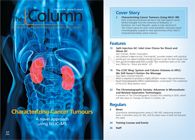The Chromatographic Society: Advances in Microcolumn and Related Separation Technologies
A preview of The Chromatographic Society’s first meeting in 2016, which will take place on Tuesday 22 March in London, UK.
Photo credit: vladimir zakharov/Getty Images

A preview of The Chromatographic Society’s first meeting in 2016, which will take place on Tuesday 22 March in London, UK.
The first meeting of The Chromatographic Society’s Diamond Jubilee celebration year will be held at the Institute of Engineering and Technology (IET) in Savoy Place, London, UK, on Tuesday 22 March 2016. This venue holds special significance for the Society because it was the location of the Society’s first ever meeting held on the 30 May–1 June 1956. The Chromatographic Society has a long and proud tradition of discussing the important advances in separation science. On this occasion their inaugural meeting will focus on the latest advances in fields employing microcolumn technology and other important chromatographic developments.
The meeting has been separated into four separate sessions spread across the day. Peter Schoenmakers of the University of Amsterdam will begin the day with a discussion on liquid chromatography (LC). Peter is at the cutting edge of LC and gas chromatography (GC) academic research, and is heavily involved with the collaboration between academia and industry at the TI-Coast in the Netherlands. As a result, Peter can bring an important perspective on research in academia and its application in industry. Peter’s research on 3D chromatography is particularly exciting and he will touch on this during his presentation. The next speaker in the session will be David McCalley of the University of the West of England. David is well known for his fundamental work on hydrophilic interaction chromatography (HILIC) and fundamental separation mechanisms. His talk will focus on his recent work comparing the performance of the latest separation materials. The session’s final speaker will be Ian Wilson of Imperial College London. A former President of the Society, Ian’s work now focuses on a variety of complex separation types including metabolomics and he will share some of his stateâof-the-art research with us at this meeting.
A range of sponsors will present the second session of the day. As well as the sponsor presentations, there will be a sponsor exhibition in the IET library highlighting the latest separation science products and related technologies.
The third session of the day will focus on GC and will commence with Pat Sandra from the University of Ghent, who has an extensive background in GC. His talk will discuss some of the most recent automation developments regarding sample preparation and injection for capillary GC. Tom Lynch of BP will follow and he will discuss GC column technology. Kevin Van Geem of the University of Ghent will close this session with a talk on multidimensional GC, an approach that is becoming more prevalent for the analysis of complex sample types.
The final session will focus on other separation approaches and Frederic Lynen from the University of Ghent will begin with a discussion of his group’s recent work in the field of capillary chromatography. The next presentation will be from JeanâLuc Veuthey from the University of Geneva, who will discuss some of the latest developments in the field of supercritical fluid chromatography (SFC). The final speaker in the session will be Peter Myers from the University of Liverpool, recipient of the Society’s 2016 Martin medal and a former Chromatographic Society committee member. He will bring the meeting to a close with a discussion on the future of microcolumn formats for separation science.
This speaker line up will provide chromatographers with an exciting glimpse into the cutting-edge of separation science and will also highlight an important Diamond Jubilee year in the Chromatographic Society’s history.
Chairperson: Alan. J. Handley
Tel: +44 (0)1925 248850 E-mail: chromsoc@ready2assist.co.uk Website: www.chromsoc.com

















Regulatory Deadlines and Supply Chain Challenges Take Center Stage in Nitrosamine Discussion
April 10th 2025During an LCGC International peer exchange, Aloka Srinivasan, Mayank Bhanti, and Amber Burch discussed the regulatory deadlines and supply chain challenges that come with nitrosamine analysis.
Polysorbate Quantification and Degradation Analysis via LC and Charged Aerosol Detection
April 9th 2025Scientists from ThermoFisher Scientific published a review article in the Journal of Chromatography A that provided an overview of HPLC analysis using charged aerosol detection can help with polysorbate quantification.
Regulatory Deadlines and Supply Chain Challenges Take Center Stage in Nitrosamine Discussion
April 10th 2025During an LCGC International peer exchange, Aloka Srinivasan, Mayank Bhanti, and Amber Burch discussed the regulatory deadlines and supply chain challenges that come with nitrosamine analysis.
Polysorbate Quantification and Degradation Analysis via LC and Charged Aerosol Detection
April 9th 2025Scientists from ThermoFisher Scientific published a review article in the Journal of Chromatography A that provided an overview of HPLC analysis using charged aerosol detection can help with polysorbate quantification.
